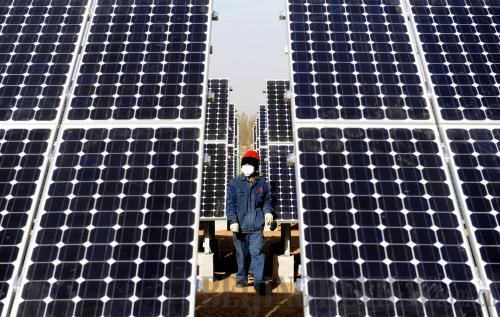|
 |
|
CONFRONTING TRADE DISPUTES: A worker checks newly installed solar cell panels in Jingbian, Shaanxi Province, on November 29, 2010. Most polysilicon used in China's photovoltaic industry is imported from foreign countries (LIU XIAO) |
China's farming industry is an even greater victim of dumping. China was once a major exporter of cotton and soybean but is today a major importer of the products. Farming land devoted to soybean and cotton has declined sharply.
The major cause of the decrease in farm productivity is dumping from countries such as the United States.
Customs figures showed that in the first 10 months this year, China imported a total of 4.3 million tons of cotton, soaring 95.8 percent from a year ago. The cost of producing cotton in the United States is much higher than that in China, but the price of U.S. cotton in China is much lower than that of Chinese cotton.
For each ton of cotton, the price difference is nearly 1,000 yuan ($158.98), making it impossible for Chinese cotton growers to be competitive, and resulting in a declining planting area. According to a survey by the China Cotton Association, the area devoted to planting cotton in 2012 is 4.85 million hectares, a decline of 9.2 percent from last year.
The Rural Development Institute of the Chinese Academy of Social Sciences estimates that in 2012 China will import 57.5 million tons of soybeans, accounting for 86 percent of the country's soybean demand, hitting a record high. In 2012 only 5.79 million hectares of soybeans have been planted, down 13.8 percent from last year. This is the fifth consecutive year that farmland devoted to soybeans in China has fallen.
Forced retaliation
China has never initiated anti-dumping investigations without being compelled to after other nations launched their own probes against Chinese products.
After the United States launched an investigation against Chinese-made tires, China launched a similar probe against chicken products from the United States. Only after the United States and the EU began anti-dumping investigations against China's photovoltaic products, China retaliated against polysilicon imports from the United States.
The MOFCOM figures show that from 2003 to September 2012, China had launched a total of 131 anti-dumping investigations and five anti-subsidy investigations involving $20 billion worth of products, much smaller than the number of trade remedy cases initiated by foreign countries against Chinese products.
According to the MOFCOM, China has increased the number of trade remedies at its disposal. Before 2009, the country's trade remedy ability was limited to investigations of dumping. Since 2009, the MOFCOM began launching anti-subsidy investigations against some products imported from the United States and the EU. Today, China has become one of the few WTO members that can adopt all the three trade remedy measures, namely anti-dumping, anti-subsidy and safeguard measures.
Tu said China interprets anti-dumping rules as a means to promote trade liberalization instead of trade protectionism, and China is becoming a responsible and rule-abiding member of the international community in that regard.
Faced with trade frictions, the first reaction from Chinese officials is not to resort to trade remedies, according to a MOFCOM statement. The Chinese Government will adopt WTO rules to actively cope with trade remedy investigations and trade barriers launched by foreign countries and promote the establishment of bilateral and regional trade cooperation.
Boosting free trade
China has dialogue channels for bilateral trade disputes with 17 trade partners including the United States, the EU, Russia, India and Brazil. It is working to establish such trade channels with organizations such as the Eurasian Economic Community and Gulf Cooperation Council.
The focus is to build an understanding of the rules during trade remedy investigations in order to enhance mutual trust, reduce disputes and resolve frictions. Even if consultations fail, China will first defend itself in any trade litigation.
At present, China is actively participating in negotiations and the formulation of international rules to ease trade frictions between nations. The MOFCOM says a multi-lateral trade mechanism is important to maintaining global free trade, and that China hopes international trade rules to be open, inclusive and non-discriminative.
Email us at: lanxinzhen@bjreview.com | 